US food benefit programs. This analysis on how many people benefit, how they benefit, what it costs, and how to improve the system is timely with Congress currently funding the programs
I put this 15 page report together in March, and published part of it previously. Please go to the substack site for the entire report, as it may be too large for email.
A lot of ink has been spilled over the USDA’s recent cancellation of a $1.1 Billion program intended to provide fresh, locally raised food to schools, food pantries, and disadvantaged individuals.[1] The program certainly looked like a triple-win program for small farmers, children and the poor. USDA was accused of taking food from the mouths of babes.
However, USDA is releasing funding for all existing agreements and has not reneged on any contracts. USDA simply announced that it will not be carrying out another funding round for this program, which had been crafted for the purpose of managing supply chain interruptions during the pandemic.
In response, the national School Nutrition Association arranged for over 800 of its members to visit Congress on March 11, demanding the funding be restored. A group of Democrat Senators promised to support them with a letter to the USDA Secretary. And on March 12 Senator Fetterman filed a bill to cancel all student lunch debt across the country, which amounts to about $176 million a year.
But what none of the media have done is examine how this USDA program came to be, how it is funded, how the United States provides food aid to its citizens and how federal programs designed to help Americans obtain a healthy diet might need a serious overhaul.
What does food aid cost the United States?
Very few people know that USDA spent over $200 Billion dollars in 2021 (during the pandemic) on food and nutrition assistance for Americans. After the pandemic ended, it spent $166.4 Billion in 2023 on a variety of programs. The 2023 level of spending is equivalent to $500 collected from every single American for just one year. Taxes must cover this cost.
A full list of USDA beneficiary programs for food and nutrition in 2023 is included in the Appendix.
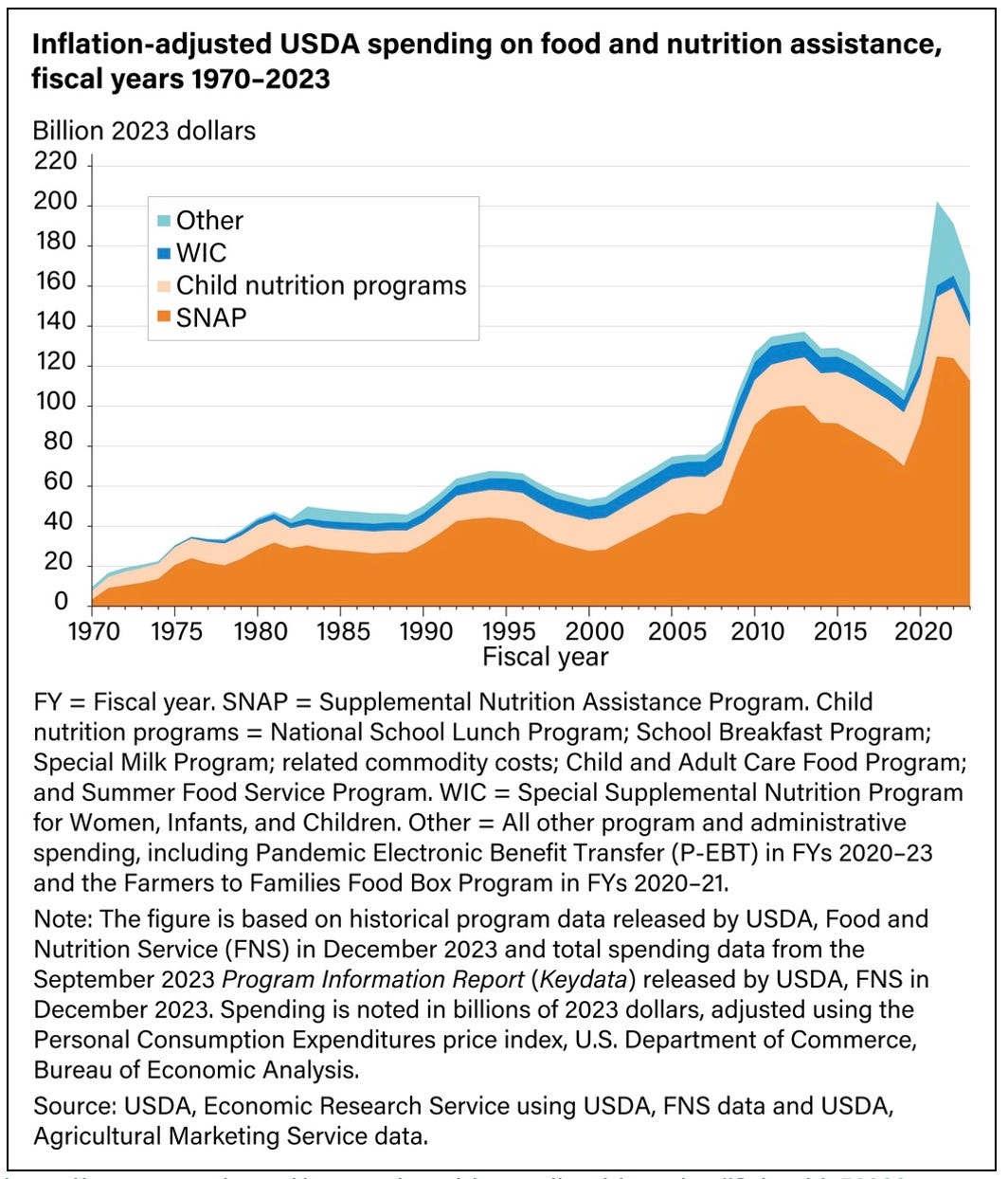
https://www.ers.usda.gov/data-products/chart-gallery/chart-detail?chartId=58388
The US Government believes that 10-15% of schoolchildren are food insecure, but this assessment may not be accurate.
18 million American households were designated as food insecure for some (any) period during 2023, or 13.5%. This number is extrapolated from self-reporting to US census-takers, who collected detailed information on diet from about 30,000 US households.[2]
However, according to USDA’s Economic Research Service,[3]
“About 58 percent of food-insecure households participated in one or more of the three largest Federal nutrition assistance programs from the U.S. Department of Agriculture’s Supplemental Nutrition Assistance Program (SNAP); the Special Supplemental Nutrition Program for Women, Infants, and Children (WIC); and the National School Lunch Program during the month before the 2023 survey.”
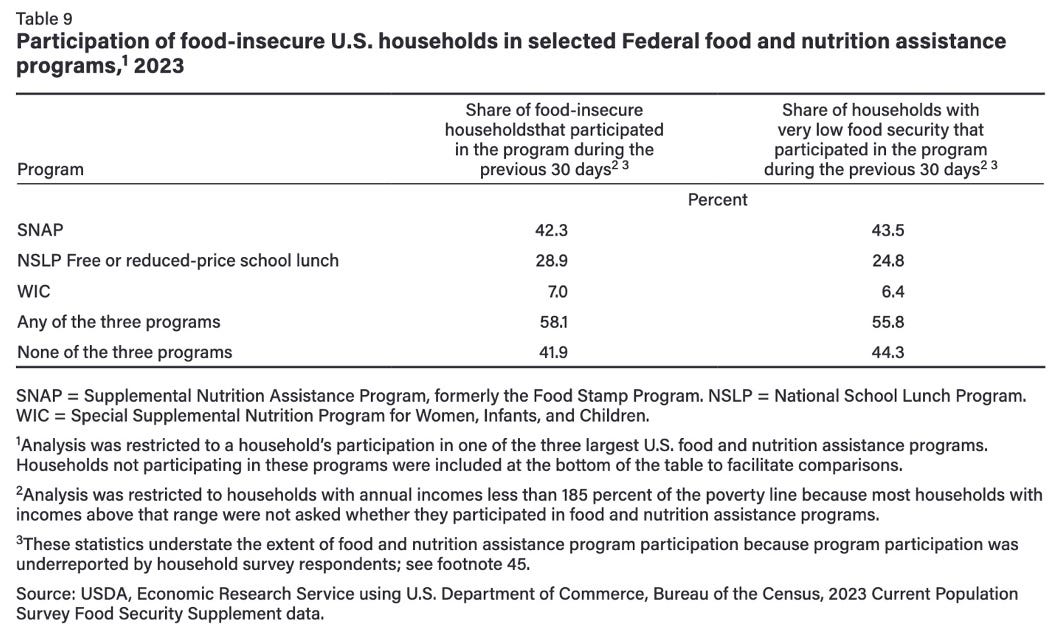
https://files.eric.ed.gov/fulltext/ED631898.pdf
If these numbers are correct, why did 42% of the food-insecure households receive no food benefits from the USDA’s 3 largest programs? Do problems of access need to be addressed?[4]Are millions of households that are not thought to be food-insecure receiving the benefits? How close is the match between needy families and beneficiaries? Can we do better?

In 2023, 42 million Americans or 12.5% of the population received SNAP benefits.[5] SNAP, the Supplemental Nutrition Assistance Program was previously called the Food Stamp program. It was created about 60 years ago. Low-income Americans who meet income and other guidelines can receive up to $292/month for a single person, and up to $973/month for a family of four in the continental United States. The benefits are higher in Alaska, Hawaii, Puerto Rico and other non-contiguous territories. Beneficiaries receive an EBT card, which works like a debit card, but may only be used to buy food and non-alcoholic beverages.
Approximately 10% of overall SNAP funds are spent for soda and other sweetened drinks. There has long been discussion of whether soda should be excluded from SNAP benefits, but the sugar and soda industries have effectively lobbied to retain unhealthy drinks, even going so far as to fund organizations that accuse those who wish to reduce soda consumption as racist.
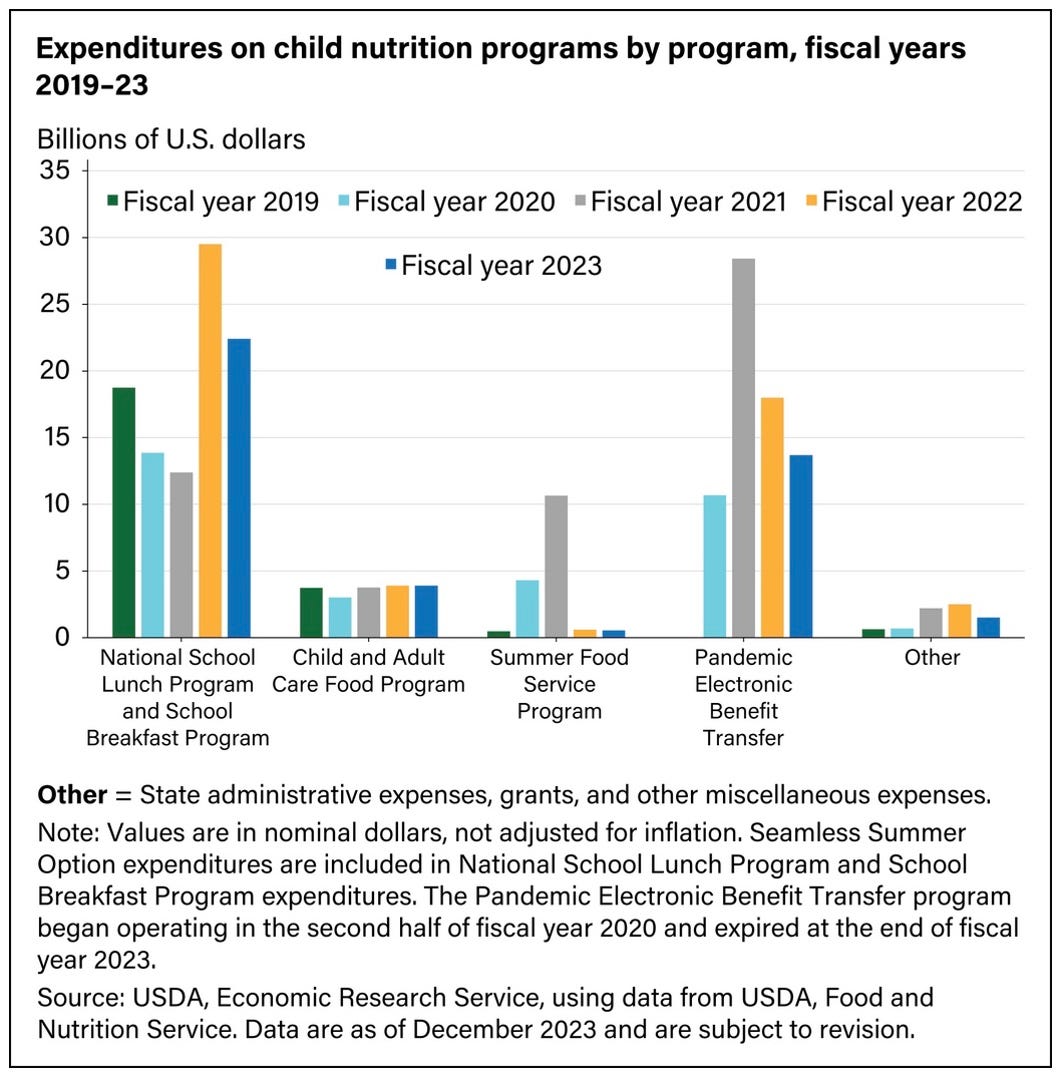
https://www.ers.usda.gov/data-products/chart-gallery/chart-detail?chartId=103099
How much is spent on the school lunch program?
The federal school lunch program includes breakfasts and after-school snacks in addition to lunches for beneficiaries, and it cost over $22 Billion dollars in 2023, or the equivalent of $67/year contributed by each American. If we canceled school lunch debt and provided free lunches for every school child, it would cost roughly 2-3 times this much.
Eight state legislatures have already chosen to provide free meals to all their school students. In Maine, the state’s budget for these meals is estimated at $70 million dollars for 172,000 schoolchildren, with additional contributions by the federal government.
What is the reimbursement rate for school meals?
The federal government provides approximately $7.60 per child per day to cover breakfast ($2.37), lunch ($4.01) and an afterschool snack ($1.21) (for those in the afterschool program).[6] Schools may also offer reduced-price meals, with most of the cost paid by the federal government, and schools also sell food items to students. School cafeterias are obviously on a tight budget, with few being able to provide nutritious meals, generous portions, and local food on the federal allotment. So, what do they do?
Most schools outsource some, or all, of their meal preparation to “Big Food” catering companies. Their food selections are notably high in sugar, salt and fried items. Despite efforts by large catering companies to make the foods tasty for children, students generally prefer the “meals from scratch” to the industrial “heat and eat” selections in school cafeterias.
While the School Nutrition Association refers to a study claiming that school lunches are the most nutritious meal of the day for schoolchildren, what we know is that most of the meals are sorely lacking in nutrition, and contain excessive amounts of sugar, other carbohydrates and ultra-processed ingredients that are relatively depleted of nutrients.
“In recent years, Big Food companies — and their industry associations — have spent millions of dollars lobbying the federal government to weaken or change its nutritional standards, and these efforts have paid off handsomely. It happened in 2014, when the U.S. Department of Agriculture (USDA) caved to industry pressure and made it easier for schools to serve French fries and pizza. It happened in 2018, when the USDA loosened restrictions on the amount of sodium, flavored milk, and refined grains that could be served in school meals….
When the National School Lunch Act was passed in 1946, school food program directors — many of them trained in home economics or dietetics—persuaded Congress that for-profit operators had no place in the not-for-profit world of the federal lunch program….
Facing intense pressure also from the National Restaurant Association, a powerful trade lobby representing the food service industry (and often referred to by food justice advocates as “the other NRA”), the USDA then decided, in 1970, to lift its restriction on for-profit providers…”[7]
How have America’s children done? We are seeing the highest rates ever of obesity and diabetes in children. CDC’s chart of childhood obesity[8] below, spanning 55 years, ends 7 years ago, but things have only gotten worse since then.
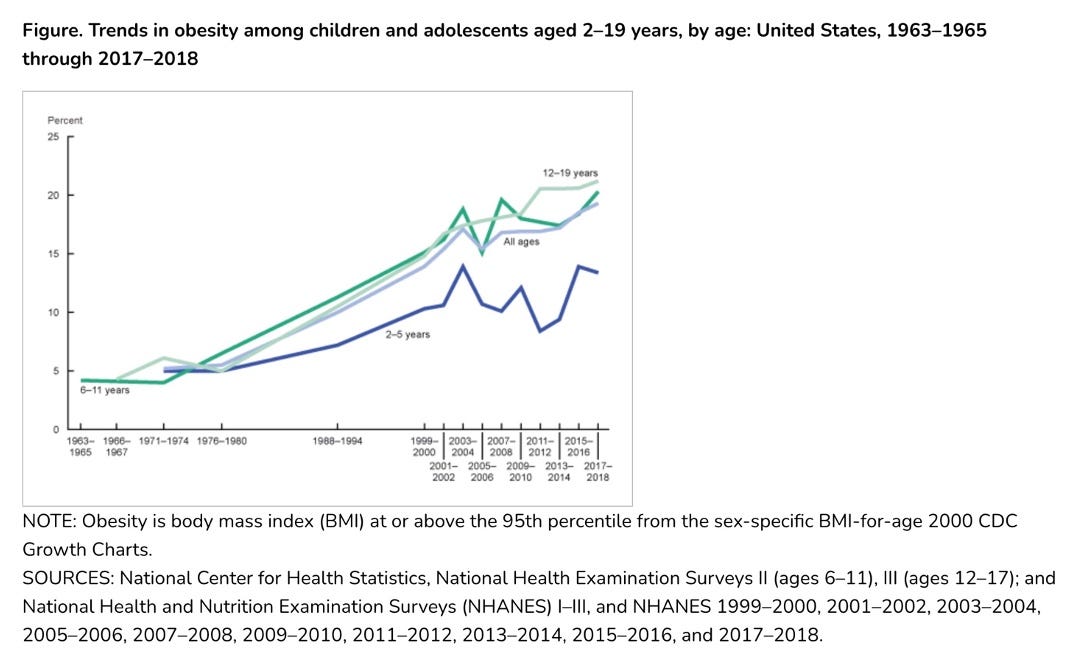
Here is another useful federal chart of childhood obesity, with a breakdown by race/ethnicity, which comes from America’s Children: Key National Indicators of Well-Being, 2023[9]
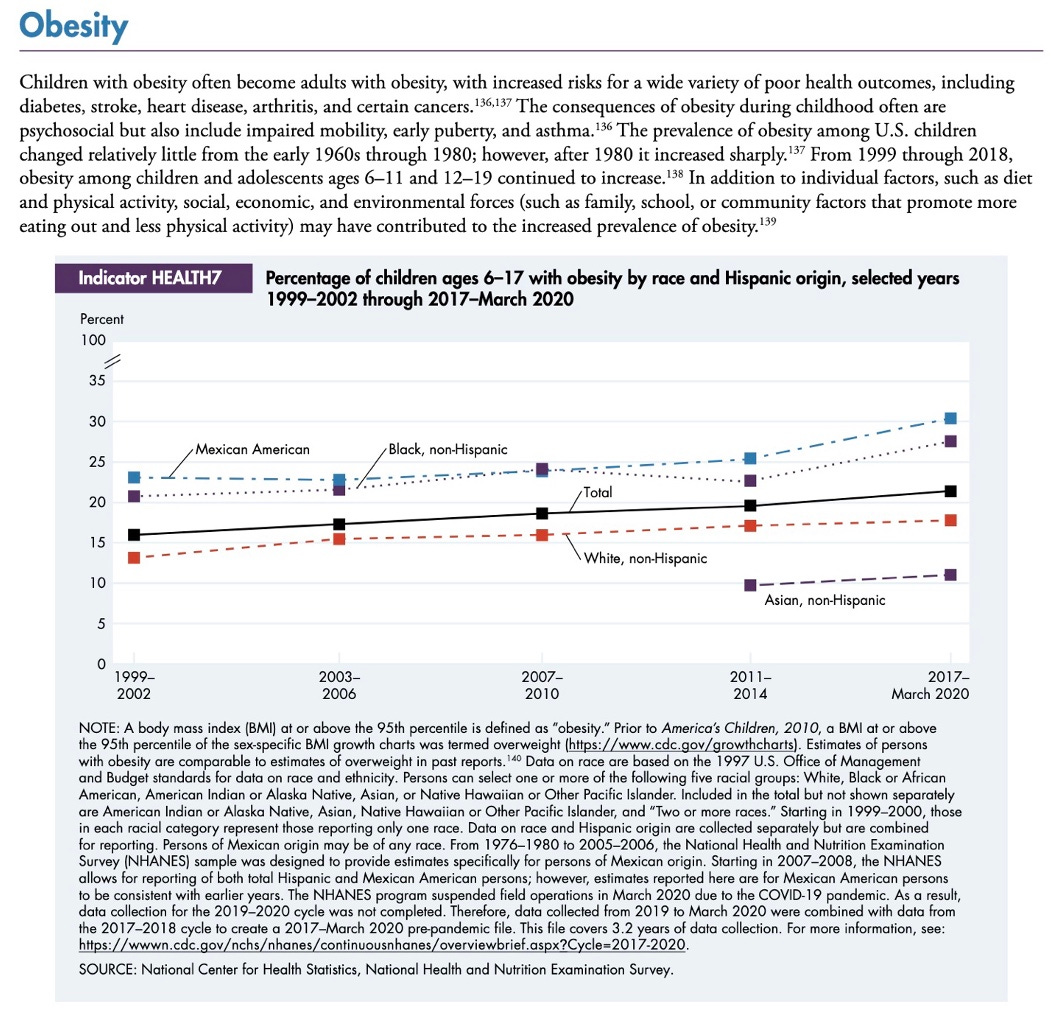
The rate of type 2 diabetes in adolescents doubled between 2000 and 2017, and the rate of type 1 diabetes rose as well.[10]
The federal government went to great lengths during the pandemic to provide food aid to children and poor adults. These programs were not expected to extend beyond the pandemic.
For example, during the pandemic,
“The U.S. Department of Agriculture (USDA) waived the eligibility requirements for free lunch to allow school meal programs to provide safe, free healthy meals to all children and these flexibilities were extended through June of this year.”[11]
In addition, to compensate for school closures, expanded pandemic benefits for children (termed P-EBT) were made through the SNAP program, and income restrictions for free school meals were waived.[12] When schools were shut, the federal government paid schools to produce and package meals that were sent to families at home, using school buses as food delivery vehicles.[13]
Cancelled earlier this month were two additional food benefit programs created during the pandemic. One was the Local Food for Schools (LFS) Cooperative Agreement Program.[14] Each grant was designed to support socially (and not necessarily economically) disadvantaged producers, who were defined by LFS in the FAQs issued by USDA:
“Q6. The RFA says that purchases must target socially disadvantaged farmers and producers and small businesses. Can you expand more on what is meant by socially disadvantaged producers? Are purchases limited to those producers or is this just a target?
A6. For the purpose of this program, “socially disadvantaged” is a farmer or rancher who is a member of a Socially Disadvantaged Group. A Socially Disadvantaged Group is a group whose members have been subject to discrimination on the basis of race, color, national origin, age, disability, and, where applicable, sex, marital status, familial status, parental status, religion, sexual orientation, genetic information, political beliefs, reprisal, or because all or a part of an individual’s income is derived from any public assistance program.”[15]
Funding for the LFS program came from the USDA’s Commodity Credit Corporation.[16]
A sister program, the Local Food Purchase Assistance (LFPA) Cooperative Agreement Program was begun with a similar mission, while targeting socially disadvantaged recipients as well as food producers.[17] Funding for the initial year of the LFPA program came from Congressionally authorized funds. But funding later came from the Commodity Credit Corporation, when the program was renamed LFPA-Plus.
The non-competitive, cooperative agreements, “allow the states, tribes and territories to procure and distribute local and regional foods and beverages that are healthy, nutritious, unique to their geographic areas and that meet the needs of the population… and to maintain and improve food and agricultural supply chain resiliency”[18] Furthermore, there was a goal to “expand economic opportunity for local and underserved producers.”
While these were all salutary goals, the initial grants invited abuse, as the producers and recipients were selected in a non-competitive manner, with limited follow-up. NGOs or for-profit companies were chosen to receive grants by the states to carry out the program of work. For example, Vermont’s SUSU CommUNITY Farm received an initial $45,000 to provide, “a no-cost box of African diasporic and culturally relevant foods, herbal medicines, eggs, flowers and other items each week for 20 weeks to 45+ families in Windham County, Vermont.”[19] This organization’s 2022 IRS Form 990 indicates it delivered 1,330 boxes of food (under other contracts) at an overall cost of $234 per box.[20]
Shortly before leaving office, the Biden administration issued another funding opportunity for these 2 programs, offering the states approximately $660 million in grants for LFS and $440 million for LPFA-Plus. But by then the pandemic was over.
The grants were designed to provide local fresh produce, meat, eggs and dairy to local consumers. This is exactly what local food producers and consumers desperately need. But while one more set of grants to a plethora of community organizations would have been helpful, the grants were associated with a paucity of state or federal oversight and no plan for continuity. They provided no solution to the problem of America’s overall reliance on industrial food, which begins in school cafeterias.
A dive into the provenance of LFS and LFPA spending revealed a source of unaccountable funds within USDA
The Biden administration’s 2024 offer of another year of LFS and LPFA programs tapped a little-known source of funds that is essentially outside Congressional oversight.
Nearly 100 years ago, during the Great Depression, the Commodity Credit Corporation[21] [22] was created within USDA to provide funds that could be used to control commodity prices and keep farmers from bankruptcy in bad years.[23] [24] Over time, this fund grew to $30 Billion dollars a year, which could be drawn from the Treasury for a variety of purposes. These purposes included climate-oriented programs, and programs favoring politically important regions. Both parties have been accused of directing this considerable source of support for political purposes. This is how the LFS and the LFPA-Plus were funded under the Biden administration.
Should ad-hoc funding for an idiosyncratic food program (because it was not directed to those with principally economic need) be coming from what has turned into a slush fund? Shouldn’t Congress limit the purposes for which this fund can be used, and shouldn’t the government be restricted to only spending authorized funds?
The federal debt and the contribution of our food programs to it
During the last fiscal year, the federal government spent $1.8 trillion dollars more than it took in. $1.8 trillion dollars of debt, divided by the number of Americans, means each of us is responsible for $5,300 in debt, for last year alone! Some of that debt is due to interest payments on the cumulative federal debt, which now costs $1 Trillion dollars a year to service, or about $3,000 dollars per person. The total federal debt of $36 Trillion dollars is equivalent to more than $100,000 owed for each American. That is how much our government has borrowed, per person, and we are placing that debt on our children’s and grandchildren’s shoulders.
This is why it is critical for the US to get its spending under control. Congress has proven they will kick this can down the road forever. They want as much money as possible spent in their districts to influence votes for the next election. It is only the President, especially because he will not be running for office again, who can begin managing our massive debt. And that means that non-essential programs will need to be cut. But we can still find win-win solutions to the problems that have been described here.
SOLUTIONS
1. The two canceled programs were designed ad hoc, without guardrails, for the pandemic. Rather than duplicating them, an expanded program for purchase of local food from local providers should be created, with clearer guidelines, to serve both producers and recipients who are economically disadvantaged. Beneficiaries should be able to choose the foods they want, rather than being provided with a selection of foods chosen by a local vendor. Year-to-year continuity should be maintained.
An improved program could be an expansion of the Farm Fresh Rewards[25] program in Maine, which allows shoppers to use their EBT benefits to buy fresh produce at participating sellers, including groceries, farm stands, food co-ops and health food stores for half price, greatly incentivizing the purchase of healthy, local foods.
2. School meals, despite meeting federal nutrition guidelines, are not healthy. Most free school meals are currently being provided to students who do not meet the definition of food-insecure. The schools have taken over the role of the parents, believing their students are undernourished. But as they came to provide increasing numbers of students up to 10 meals per week, the students became less and less healthy.
There should be a financial needs assessment for free meals, and students who are not needy should provide their own meals. The federal allotment per meal could then increase substantially.
American school lunch programs were initiated to support children in need, not all children. While universal meal provision is a laudable goal, it is at the same time regressive, because it transfers wealth from the community to children from well-off families. It furthermore disincentivizes families from sending more wholesome meals from home. This is a moral hazard that shifts dependency to a government that is unduly influenced by Big Food.
Food should be purchased and prepared locally for schoolchildren, and “Big Food” and “Big Sugar” should not be permitted in school cafeterias. Perhaps a bonus payment for schools that buy from small local producers could be established.
3. Nutrition guidelines, which are developed jointly by USDA and HHS, must be revamped, and the plan is for this to occur in late 2025. These guidelines set the standard for school meals. Strict adherence to healthy guidelines must be a requirement for school participation.
4. SNAP benefits should not cover sweet drinks. School cafeterias should not sell sweet drinks or chocolate milk.
5. Health classes should teach all children about nutrition and even healthy weight loss diets. Diet and cooking clubs should be encouraged to teach students about healthy, tasty food choices. Adult diet and cooking classes should also be encouraged.
6. All federal nutrition programs must be Congressionally authorized, as should CCC expenditures, which should correspond with the CCC program’s original intent. Congress should close the loophole that allows broad use of Commodity Credit Corporation funds.
7. All federal beneficiary programs should result in a net benefit to the United States as well as to individual beneficiaries. All programs should be required to assess their overall, long-term benefits. If the school lunch program increases the costs of healthcare later, neither the individual beneficiaries nor the nation will benefit from the program in the end. President John F. Kennedy invigorated the nation with the need for physical fitness and vitality, especially in the schools.[26] We can do this again.
8. The federal government must conduct a review including both a needs and accessibility assessment, to be sure its food and nutrition benefits are reaching our economically neediest citizens. Beneficiaries should be incentivized to purchase the healthiest foods and receive sufficient education and funding to do so. Funding for emergencies must be available.
Appendix
Below is a list of all USDA food and nutrition benefit programs active in 2023
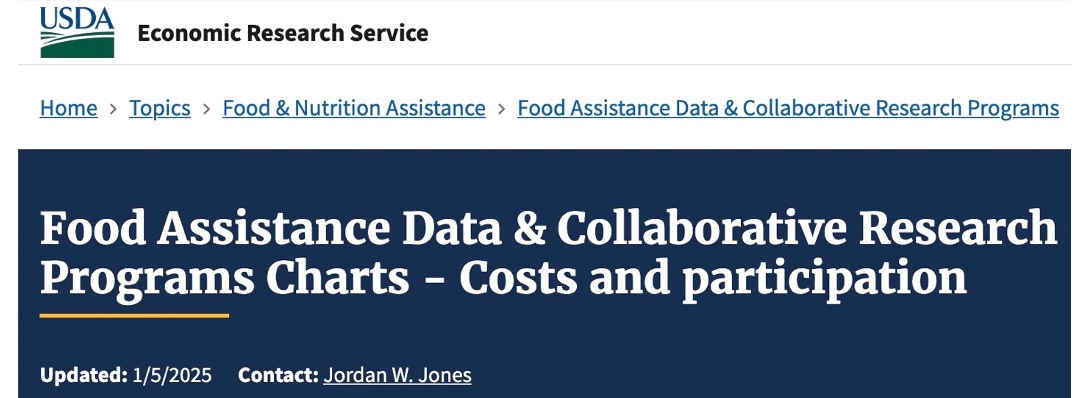
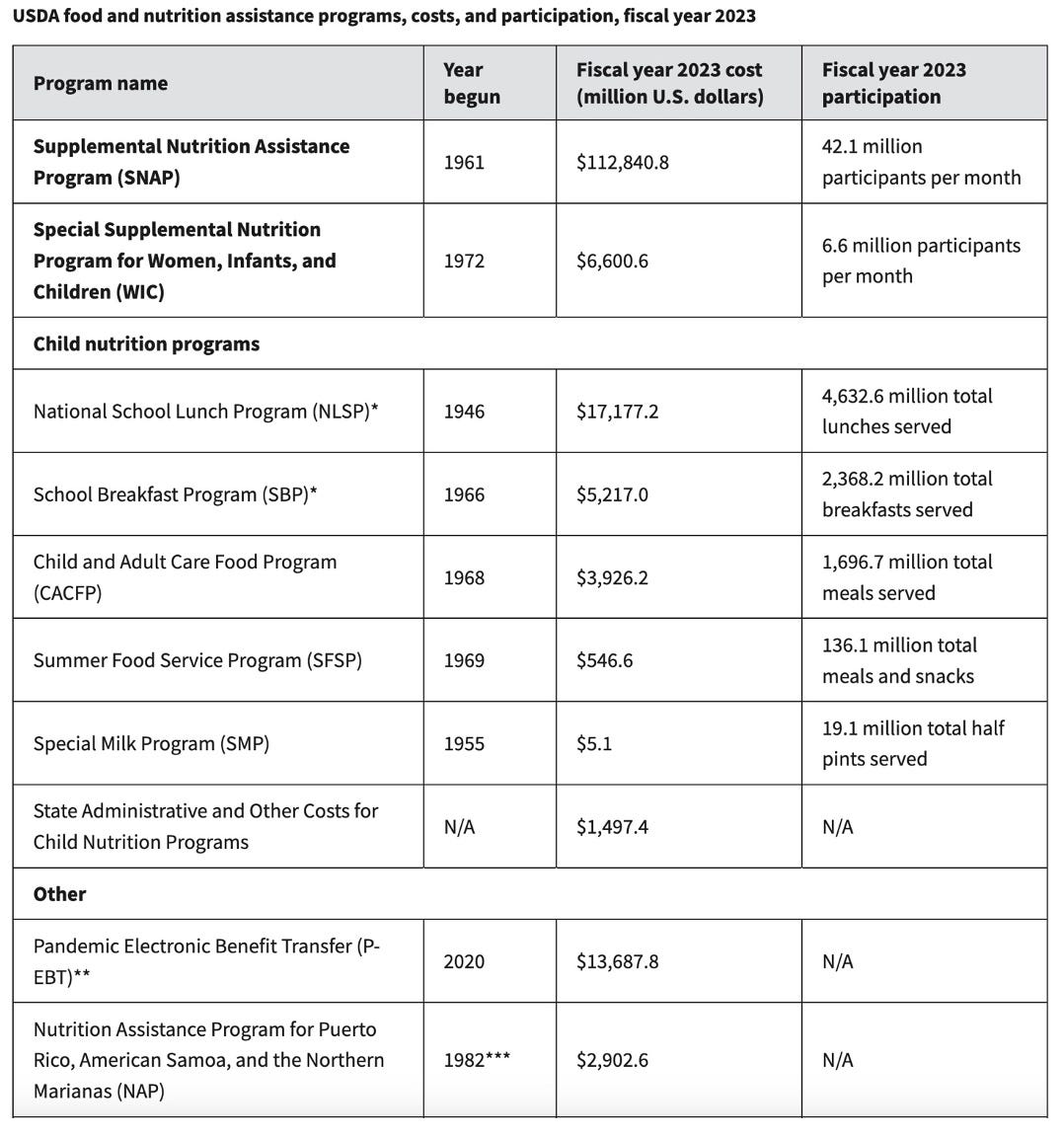
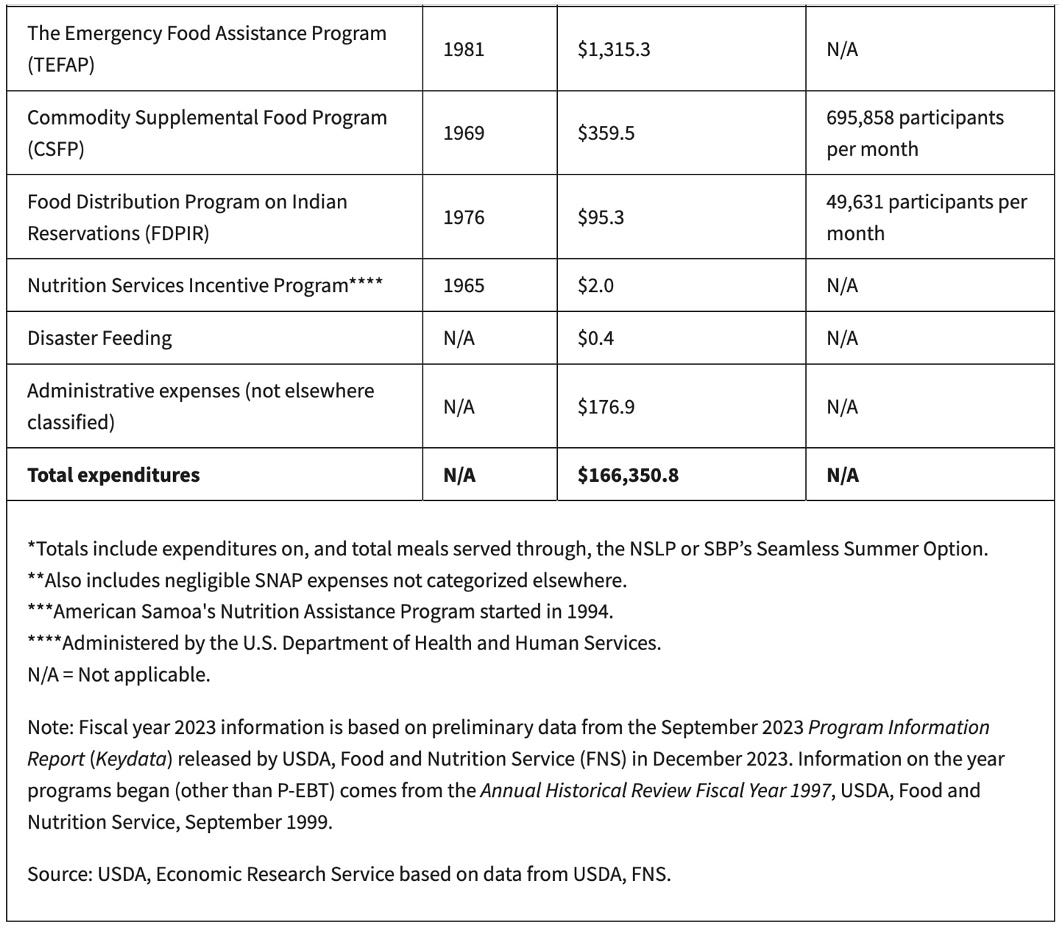
[1] https://agriculture.vermont.gov/agency-agriculture-food-markets-news/usda-funding-local-food-purchasing-programs-terminated
[2] https://ers.usda.gov/sites/default/files/_laserfiche/publications/109896/ERR-337.pdf?v=84831
[3] ibid
[4] https://pmc.ncbi.nlm.nih.gov/articles/PMC10733882/
[5] https://www.ers.usda.gov/topics/food-nutrition-assistance/food-assistance-data-collaborative-research-programs/charts/expenditures
[6] https://www.fns.usda.gov/school-meals/fr-071024
[7] https://kappanonline.org/big-business-school-meals-food-service-gaddis/
[8] https://www.cdc.gov/nchs/data/hestat/obesity-child-17-18/obesity-child.htm
[9] https://files.eric.ed.gov/fulltext/ED631898.pdf
[10] https://jamanetwork.com/journals/jama/fullarticle/2783420
[11] https://www.census.gov/library/stories/2022/04/less-hunger-in-at-risk-households-during-pandemic-expansion-of-school-meals-program.html
[12] https://www.ers.usda.gov/topics/food-nutrition-assistance/child-nutrition-programs/national-school-lunch-program
[13] https://www.census.gov/library/stories/2022/04/less-hunger-in-at-risk-households-during-pandemic-expansion-of-school-meals-program.html
[14] https://www.ams.usda.gov/selling-food-to-usda/lfs
[15] https://www.ams.usda.gov/selling-food-to-usda/lfs/faqs
[16] https://www.ams.usda.gov/sites/default/files/media/LFSRequestForApplicationsVersion3.pdf
[17] https://www.ams.usda.gov/selling-food-to-usda/lfpacap
[18] ibid
[19] csa — SUSU commUNITY
[20] https://www.causeiq.com/organizations/view_990/874165704/8bc51b43628bebf178827
d0d22519784
[21] https://www.usda.gov/farming-and-ranching/resources-small-and-mid-sized-farmers/commodity-credit-corporation
[22] https://www.congress.gov/crs-product/R44606
[23] https://farmdocdaily.illinois.edu/2024/06/budgetary-dissonance-and-the-2024-house-farm-bill.html
[24] https://www.aei.org/research-products/report/administrations-can-currently-raid-commodity-credit-corporation-funds-for-their-own-initiatives-good-idea-or-bad-idea/
[25] https://www.nutritionforme.org/blog/what-is-farm-fresh-rewards/
https://www.youtube-nocookie.com/embed/E0WmpszjnN8?rel=0&autoplay=0&showinfo=0&enablejsapi=0